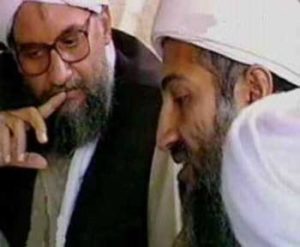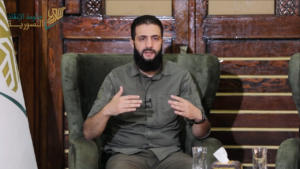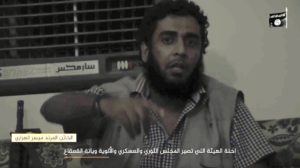[Editor’s Note: Jihadica is pleased to welcome Lina Raafat and Charles Lister. Lina is a research assistant for the Extremism & Counter-Terrorism Program at the Middle East Institute. Her research focuses on militant propaganda with a particular focus on foreign fighter mobilization and logics of martyrdom. Charles is a senior fellow and the director of the Extremism & Counter-Terrorism Program at the Middle East Institute.]
The fall of southwestern Syria to Bashar al-Assad’s regime marked a significant turning point in the Syrian conflict, effectively shifting attention to the northwestern province of Idlib, the last remaining opposition stronghold. Home to a wide array of armed resistance groups, including groups with former and current ties to al-Qaeda, as well as defeated opposition fighters recently exiled from elsewhere in Syria, Idlib’s dynamics are incredibly complex and warrant special consideration. As the threat of an impending regime offensive continues to develop, with both Russia and Turkey bolstering defenses, armed opposition groups find themselves under unprecedented pressure to adapt to the evolving dynamics, both on the ground and in surrounding geopolitics.
A prime example of such adaptation is Hay’at Tahrir al-Sham, or HTS. Previously known as Jabhat al-Nusra, this former al-Qaeda affiliate has rebranded itself twice—first as Jabhat Fatah al-Sham (JFS) in July 2016, and later as HTS in January 2017—in a relentless effort to expand its power and present itself as a sustainable model capable of continuing the fight against the Assad regime. Today, HTS has asserted military dominance in the northwest, has established a “Salvation Government,” and is reportedly engaged in active political discussions with several regional states.
Central to the HTS model is its propaganda apparatus, which the group has employed effectively to achieve its broader strategic objectives. Faced by the impending threat of all-out hostilities, mainstream armed opposition groups have focused their propaganda on highlighting military operations and their willingness and plans to target regime forces. HTS, on the other hand, has substantially amplified its governance efforts, especially emphasizing three pillars: the provision of public goods and services; the maintenance of law and order, including through fighting terrorism (mainly ISIS); and delegitimizing any attempts of “reconciliation” with the regime.
Through a complete mapping of HTS’s entire propaganda output between June 18, 2018 and August 31, 2018, this article takes an in-depth look at how the explosion of hostilities in southwest Syria has propelled HTS to adapt its media strategy to gain (or regain) local support and to legitimize itself. The data implies that, at least when it comes to its online dissemination, HTS propaganda is geared overwhelmingly towards local messaging and aims to highlight steps taken by the group to tackle issues that are most pressing for its local constituents.
Our data set is comprised of every piece of propaganda published by HTS’s official media arm, Ebaa News Agency, during the period in question. This includes statements, video reports, photo reports, newsletters, infographics and opinion articles. Each of these individual data points was coded and analyzed to draw patterns on how the group’s strategy has been changing, and why. When examined closely, the data demonstrates a concerted attempt by HTS to expand its governance efforts and focus on issues that touch the daily lives of its people, or at least it is creating the illusion of doing so. According to the data, 57 percent of HTS propaganda focuses on governance and local grievances, while only 21 percent focuses on military activities. The remaining 22 percent is geared towards delegitimizing regime soldiers, militias, and opposition factions that have agreed to “reconcile” with the Assad government.
At this critical juncture in HTS’s trajectory, maintaining local support could be just as important a survival strategy as achieving battlefield dominance, if not more important. In a little over two months, HTS has released over 900 reports and statements highlighting the active steps taken by its officials to deal with issues critical to its perceived constituents. Those include: building roads, restoring water access, providing employment opportunities, diffusing explosives, arresting criminals, and restoring the rule of law. As the Assad regime continues to expand its grip on power and regain control of formerly “liberated” areas elsewhere in Syria, HTS appears to have re-examined its prioritization of anti-Assad military operations and pivoted to emphasizing its governance efforts in Idlib as “an exemplary model for contemporary revolutions.”
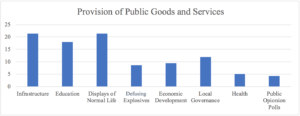
A key element of this model is, perhaps ironically, HTS’s campaign to combat terrorism. Though itself deemed a terrorist organization by many, including the United States, HTS has launched an extensive counterterrorism campaign targeting ISIS sleeper cells in Idlib. As figure 1.2 demonstrates, the group’s law-and-order campaign has predominantly focused on tracking down ISIS sleeper cells, with over 60 percent of its security operations explicitly aimed at arresting alleged ISIS members, confiscating their weapons, and in some cases publicly executing captured members and commanders. Since the beginning of the Dar’aa offensive, HTS has claimed responsibility for the capture of at least 97 ISIS fighters and commanders and the killing of another 23.
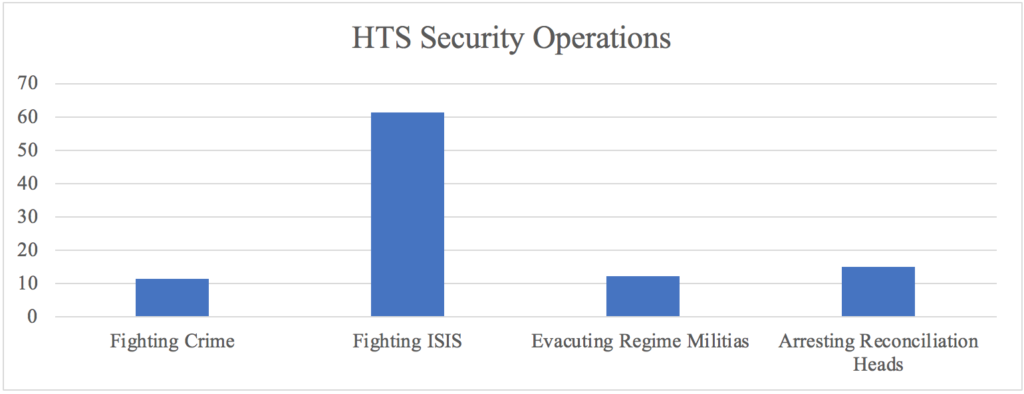
At first glance this may seem a departure from the group’s earlier strategy of steering away from public spectacles of violence, a technique which its foe—ISIS—has used to demonstrate supremacy and to attract recruits. However, this should come as no surprise, since the Assad regime has framed its war as a fight against “terrorists” and has used the presence of ISIS cells or groups linked to al-Qaeda as justification for launching large-scale offensives. By actively targeting and fighting one of the world’s most notorious terrorist organizations, HTS is attempting not only to strip away the regime’s credibility of using terrorism as an excuse to attack Idlib, but also to portray itself as a legitimate non-terrorist actor, especially in the eyes of local populations which have, on occasion, compared it to ISIS.
In addition to providing basic services and fighting terrorism, another important component of HTS’s recent propaganda effort is directed at the delegitimization of identified enemies of the group. Targets of this campaign include: the Assad regime along with its militias and allies; the international community for its perceived complicity in the war against innocent Syrian civilians; Syria’s exiled political opposition for failing to provide an effective political solution; and most importantly “reconciliation,” which HTS depicts as an existential threat to the people of Idlib.
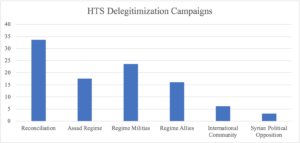
As figure 1.3 indicates, 33 percent of HTS delegitimization campaigns since mid-June have been directed at “reconciliation”—the Assad regime’s chosen mechanism for regaining control of opposition-held areas. Such “reconciliation” scenarios have played out in each of Syria’s de-escalation zones, first in Eastern Ghouta in April 2018, then Homs in May and Dar’aa in June. Now, finally, the regime’s eyes are on Idlib as its next and perhaps final target. In truth, the regime’s “reconciliation” strategy represents an offer of surrender to avoid the prospect of a catastrophic, brutal attack from the air and ground. Frequently, “reconciliation” deals have followed long-drawn-out sieges, or bombing campaigns, or even chemical weapons attacks in the case of Eastern Ghouta in April.
However, both the regime and HTS understand that the situation in Idlib is far more complex than in previous cases. In a video statement released on August 21, 2018, HTS leader Abu Muhammad al-Jolani stressed that people in the “Liberated North” are well aware of regime plans and refuse to concede:
The phase through which the jihad in al-Sham is passing today needs us, as fighting factions, to pledge before God, Glorified and Sublime, then before our patient people, that the weapons of the revolution and jihad—that trust which the Muslims have bestowed on us—are a red line that will never be bargained with and will never be on the negotiating table. For our weapons are the source of our power and pride, and they are our bedrock. The very moment one of us thinks about negotiating his weapon, he has effectively lost it. Just thinking of surrendering to the enemy and turning over our weapons is a betrayal of God and His prophet, of the blood of the martyrs, and of the prisoners and the displaced—a betrayal of our people who have sacrificed and given so much, our people who have remained steadfast for seven years in the face of oppression and criminality. What happened in the south, the honorable sons of al-Sham will not allow to happen in the north.
Jolani’s statement comes at a critical time when HTS is under immense pressure to dissolve itself and merge with the Turkish-backed National Liberation Front (NLF), which has become the largest armed actor in Idlib, comprising ten Free Syrian Army (FSA) factions, the Syrian Liberation Front, or SLF (Ahrar al-Sham and Harakat Nour al-Din al-Zinki), Jaysh al-Ahrar, and Suqour al-Sham. HTS has issued multiple statements refuting all rumors of any impending dissolution and reiterating its commitment to defend its people from the looming threat of a regime offensive as an independent group. On the contrary, a recent statement issued on August 28 indicated that dissolution remained “an internal matter” and that HTS was “working hard” to come to a workable solution that “spares our people from likely attack.”
Though adamant about maintaining its independence, HTS’s core leadership understands very well that it needs to cooperate with the other factions if it stands any chance of survival. This was made clear in Jolani’s remarks, where he emphasized the urgency of higher degrees of military coordination between different fighting factions on the battlefield and announced the establishment of a joint operations room in the north to defend and protect “the honorable people of al-Sham.” As with other components of its recent propaganda strategy, this talk of “unity” is clearly aimed at convincing local communities that HTS is their defender and an intrinsic part of the broader “revolutionary” movement. Jolani stressed:
Our sorrows and our hopes are one, and our fate is one. Our enemy is out for all of us and does not differentiate between us, and will observe toward none neither bond nor treaty. The best way to confront our enemy is to be a unified front, together in love and brotherhood. All of us must play our role in this crucial battle: fighters, civil society, clergy and scholars, tribes and families. Everyone is targeted.
Whether or not HTS’s propaganda accurately reflects realities on the ground remains unclear and hard to measure, but that should not be the focus of our attention. What HTS propaganda shows is that it is appealing to its local constituents by advertising such products as services and security, creating an image of a functioning society with happy kids, busy markets, and security checkpoints at a time when people are craving any sign of normalcy in the midst of chaos. Though local skepticism of HTS is commonplace in northwestern Syria, the threat of overwhelming attack by the regime and its Russian and Iranian allies may be the one chance for HTS to regain popular legitimacy. Its propaganda is aimed entirely at achieving that result.
The fate of Idlib appears to have been sealed. The chances of Turkey and Russia being able to negotiate a political solution seem increasingly remote. The eventual regime victory will certainly lead to unprecedented levels of death and destruction, which will in all likelihood be used to fuel extremist narratives like that espoused by HTS for years to come. As the regime tries to isolate armed opposition groups by driving a wedge between them and the people, HTS is fighting for its survival by actively seeking to embed itself within society. Whether or not it has been successful, the fact remains that once the fighting begins, HTS fighters will be the first ones on the frontlines, and this more than anything will give the group the chance to bolster its credibility and justify its narrative for years to come.

